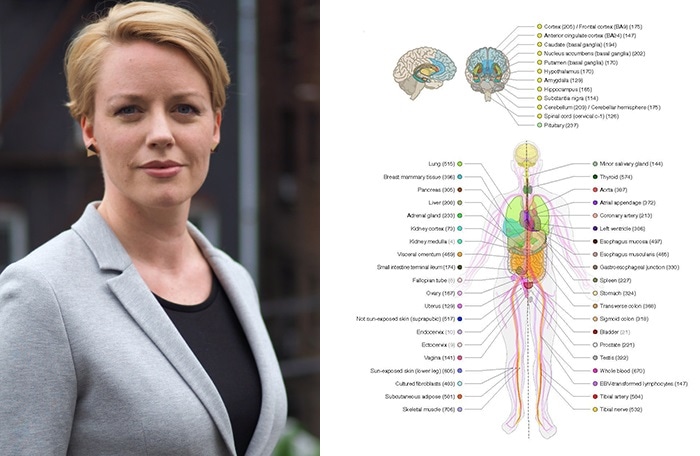The multi-institutional Genotype-Tissue Expression (GTEx) Consortium has published its final series of studies, as part of a final-phase initiative co-headed by Tuuli Lappalainen, PhD, a Core Faculty Member from the New York Genome Center.

NYGC Core Faculty Member Tuuli Lappalainen, PhD. Image Credit: New York Genome Center.
The latest study presents a detailed atlas that plots the effect of genetic variants on gene regulation and the way these cellular variations contribute to a genetic risk for both rare and common traits and diseases.
The series of 15 articles, the outcome of a decade of effort financially supported by the National Institutes of Health, was recently published in the Science and other journals.
Dr Lappalainen is the last author of the main article published in the Science journal. This article concludes the GTEx project’s study after the earlier-stage studies published in 2015 and 2017. Dr Lappalainen also holds a joint appointment as an Associate Professor in the Department of Systems Biology at Columbia University.
In the latest article, the GTEx Consortium offers an in-depth survey about an unlimited number of regulatory variants, on the basis of the GTEx version 8 dataset. This particular dataset contains a total of 15,201 RNA-sequencing samples collected from whole genome sequencing data of every donor and from 49 tissues of 838 post-mortem donors.
Dr Lappalainen jointly headed the study with François Aguet, PhD, and Kristin Ardlie, PhD, from the Broad Institute of MIT and Harvard University.
A majority of the genetic variants, which carry a risk for common diseases, are situated in genomic areas beyond the actual genes.
For a long time, scientists have hypothesized that such genetic variants should have an impact on disease risk by affecting the regulation of genes—for instance, what is the proportion of a given gene expressed in a specified tissue—but scientists had found it difficult to unravel this association. Hence, to deal with this question, the GTEx resource offers a crucial tool.
This study is a crowning collaborative achievement, in which dozens of scientists combined their expertise to build a map of genetic regulatory variation and to understand the core biology of genetic variation. GTEx resources also empower other studies by the genomics community, including disease-specific research, the identification of targets for drug development, and understanding genome function.”
Tuuli Lappalainen, PhD, Core Faculty Member, New York Genome Center
A major technique, called expression quantitative trait locus (eQTL), was used in the researchers’ study to detect the genetic variants that have an impact on the expression of genes, that is, a gene’s regulatory activity.
Simultaneously, the researchers also plotted splicing QTLs for genetic variants that affect the way RNA is spliced to varied versions of the same gene product. The team’s analysis revealed sQTLs and eQTLs for the large number of genes found in the human genome over the entire 49 tissues, rendering this the most in-depth catalog of functional genetic associations so far.
By incorporating the GTEx data with large-scale genome-wide association analyses for diseases and other features, the researchers further described the mechanisms of how the genetic effects from non-coding and coding areas have an impact on the expression of genes and how splicing regulation serves as a driver for disease.
Dr Lappalainen’s laboratory team from the New York Genome Center also made contributions to a number of other companion studies of the set of final papers of the GTEx Consortium.
A companion article, also published in the Science journal and headed by Sarah Kim-Hellmuth, MD, PhD, a former Postdoctoral Fellow in the Lappalainen laboratory, along with Dr Aguet and Dr Ardlie, has reported about a project in which the gene expression of cell types found inside the GTEx tissues was computationally dissected.
While the analyses of gene expression of certain types of cells have lately become common, a majority of the analyses cover only one tissue or a few individual ones.
Our approach allowed mapping genetic variants that affect gene regulation in different cell types for a large number of tissues. This enables better discovery of mechanisms behind genetic variants that affect disease risk.”
Dr Sarah Kim-Hellmuth, MD, PhD, Former Postdoctoral Fellow, New York Genome Center
The second article, published in the Genome Medicine journal and headed by Margot Brandt, PhD, a former student in the laboratory, explained the development and use of an experimental technique using the CRISPR genome-engineering technology to examine regulatory variants from GTEx as well as from rare disease patients.
The third article, published in the Genome Biology journal and headed by Stephane Castel, PhD, a former Postdoctoral Fellow in the laboratory, explained the GTEx allele-specific expression resource.
In addition, the Lappalainen laboratory members contributed to GTEx articles on sex-specific impacts on rare genetic variants and gene regulation.
Source:
Journal reference:
Aguet, F., et al. (2020) The GTEx Consortium atlas of genetic regulatory effects across human tissues. Science. doi.org/10.1126/science.aaz1776.